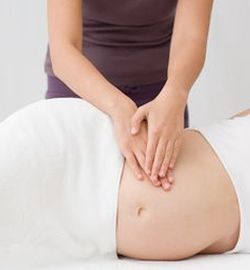 Nerve pain is characterized by a sharp and/or burning pain along the path of a peripheral or cranial nerve. In severe cases, the pain can be constant with very little that brings relief. In mild to moderate cases, the pain may come and go, triggered by certain movements or positions.
Nerve pain is characterized by a sharp and/or burning pain along the path of a peripheral or cranial nerve. In severe cases, the pain can be constant with very little that brings relief. In mild to moderate cases, the pain may come and go, triggered by certain movements or positions.
Common causes of nerve pain are herniated intervertebral discs in the spine and muscular tension that results in a “pinched” nerve. Viruses, such as the varicella-zoster virus that causes Shingles, can also be responsible for nerve pain. Tumors or blood vessels can also press upon a nerve creating pain. Sometimes, the cause of the pain is not determined.
Some nerve issues we help with Medical Massage include:
- Sciatic Nerve Neuralgia (pain down the back of the leg that may go all the way to the foot)
- Femoral Nerve Neuralgia (pain down the front of the thigh or the inside of the lower leg and knee)
- Peroneal Nerve Neuralgia (pain on the outside of the lower leg)
- Tibial Nerve Neuralgia (pain on the inside of the ankle and pain in the foot)
- Obturator Nerve Neuralgia (pain on the inner thigh)
- Carpal Tunnel Syndrome (wrist and hand pain)
- Thoracic Outlet Syndrome (pain down the arm that may go into the neck)
- Trigeminal Nerve Neuralgia (see our section on facial pain)
 Nerve Irritation vs. Nerve Compression
Nerve Irritation vs. Nerve Compression
If a spinal nerve is being compressed, it will cause intense symptoms along the path of the nerve that is affected. However, many times the nerve is not actually being physically touched by surrounding tissue. Instead, it is simply “crowded” by the pressure around it. This additional pressure around the nerve can result in a variety of symptoms, including tingling, numbess and pain. For example, patients who have a bulging disc vs. a herniated disc, can experience nerve pain. Even when the disc is not in direct contact with the nerve, it narrows the space in which the nerve is able to move. This, combined with protective muscle guarding, increases the pressure around the nerve creating symptoms.
Another important thing to note is that when there is a disc problem, the brain will signal the surrounding muscles to tighten in order to prevent excessive movement. This is to protect the nerve. Yet when the condition goes untreated, the muscles become a bigger part of the problem. As the normal resting tone of the muscles increases, the muscles develop abnormalities, such as active trigger points, that worsen the condition. There is additional pressure around the disc and the nerve from the tight muscles. The added pressure around the disc contributes to further bulging and the added pressure around the nerve creates more nerve irritation and pain. In any disc issue, it is imperative that the soft tissue is treated. With normalization of the muscles and surrounding connective tissue, pressure is decreased around the disc and the nerve, reducing symptoms and aiding the healing process.
Nerve irritation caused by tension in skeletal muscles is a common problem that is too often missed. These are problems we address and solve on a weekly basis in our office. When a nerve is just slightly irritated by a tight muscle, there is typically no pain at the site of irritation. Instead, symptoms will appear somewhere along the path of the nerve, usually at the end of its innervation.
Some conditions that may be a result of slight nerve irritation include:
- Plantar Fasciitis
- General heel and foot pain
- Knee pain
- Carpal Tunnel Syndrome
- General wrist and hand pain
- Elbow pain
- Shoulder pain
We perform simple tests to rule our or confirm nerve irritation on each patient. When nerve irritation is confirmed, the therapy is aimed at relaxing and normalizing the soft tissue in order to eliminate the pressure around the nerve.
Here is a testimonial from a patient who could barely move her shoulder when she came into the office:
“When I came to MTC, it was difficult to lift my arm. The problem had been there for a long time, but recently worsened. I had previously been treated for shoulder bursitis with a cortisone shot. When that did not work, I was sent to physical therapy. My pain did improve with the PT, but soon returned. I was certain that I must have injured my rotator cuff. At MTC, they did several tests on my first visit and told me that the problem was coming from my neck muscles being too tight around the nerves to my arm. After the first session on my neck, my pain and range of motion was a little better. But after my third visit, I could move my arm without any pain at all! I did one last session to be certain the problem was gone. I can’t thank them enough!”
J. Anderson, Sarasota
Another testimonial about knee pain that was caused by a tight piriformis muscle irritating the sciatic nerve:

